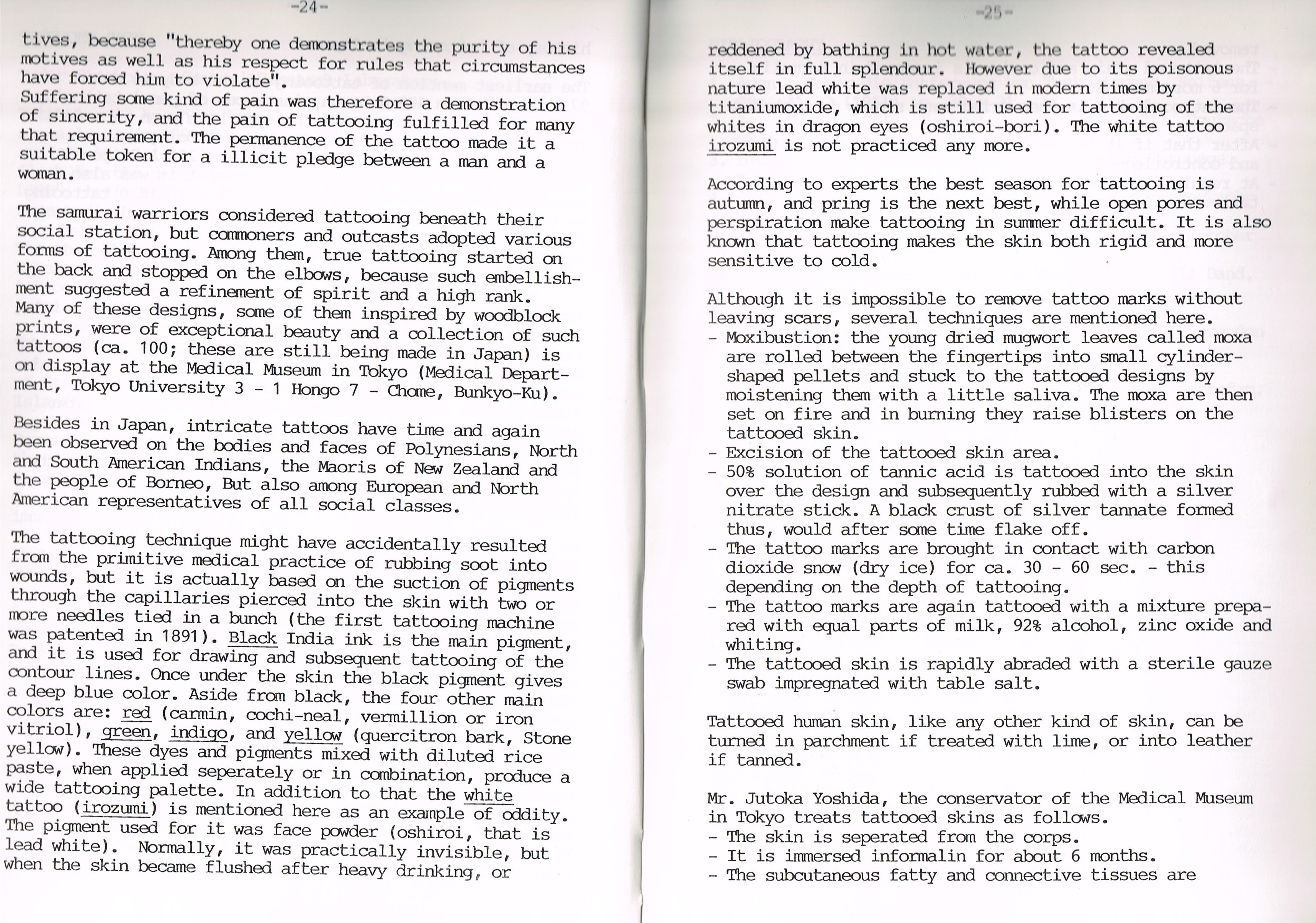CCI20140507�16

-24-
tlves, because "thereby one demonstrates the purity of his rnotives as well as his respect for rules that circumstances have forced hiin to violate".
Suffering some kind of pain was therefore a demonstration of sincerity, and the pain of tattooing fulfilled for many that regułrement. The permanence of the tattoo madę it a suitable token for a illicit pledge between a man and a woman.
The samurai warriors considered tattooing beneath their social station, but commoners and outcasts adopted various forms of tattooing. Among them, true tattooing started on the back and stopped on the elbows, because such embellish-ment suggested a refinement of spirit and a high rank.
Many of these designs, some of them inspired by woodblock prints, were of exceptional beauty and a collection of such tattoos (ca. 100; these are still being madę in Japan) is on display at the Medical Museum in Tokyo (Medical Department, Tokyo University 3 - 1 Hongo 7 - Chomę, Bunkyo-Ku).
Besides in Japan, intricate tattoos have time and again been observed on the bodies and faces of Polynesians, North and South American Indians, the Maoris of New Zealand and the people of Borneo, But also among European and North American representatives of all social classes.
The tattooing technigue might have accidentally resulted from the primitive medical practice of rubbing soot into wounds, but it is actually based on the suction of pigments through the capillaries pierced into the skin with two or morę needles tied in a bunch (the first tattooing machinę was patented in 1891). Black India ink is the main pigment, and it is used for drawing and subseguent tattooing of the contour lines. Once under the skin the black pigment gives a deep blue color. Aside from black, the four other main colors are: red (carmin, cochi-neal, vermillion or iron vitriol), green, indigo, and yellcw (guercitron bark, Stone yellow). These dyes and pigments mixed with diluted rice pastę, when applied seperately or in combination, produce a wide tattooing palette. In addition to that the white tattoo (irozumi) is mentioned here as an example of oddity. The pigment used for it was face powder (oshiroi, that is lead white). Nórmally, it was practically invisible, but when the skin became flushed after heavy drinking, or reddened by bathing Ln hol w.il ci , the tattoo revealed itself in fuli splendour. IIowever due to its poisonous naturę lead white was replaced in modem times by titaniumoxide, which is still used for tattooing of the whites in dragon eyes (oshiroi-bori). The white tattoo irozumi is not practiced any morę.
According to experts the best season for tattooing is autumn, and pring is the next best, while open pores and perspiration make tattooing in summer difficult. It is also known that tattooing makes the skin both rigid and morę sensitive to cold.
Although it is impossible to remove tattoo marks without leaving scars, several techniąues are mentioned here.
- Moxibustion: the young dried mugwort leaves called moxa are rolled between the fingertips into smali cylinder-shaped pellets and stuck to the tattooed designs by moistening them with a little saliva. The moxa are then set on fire and in buming they raise blisters on the tattooed skin.
- Excision of the tattooed skin area.
- 50% solution of tannic acid is tattooed into the skin over the design and subseąuently rubbed with a silver nitratę stick. A black crust of silver tannate formed thus, would after some time flake off.
- The tattoo marks are brought in contact with carbon dioxide snów (dry ice) for ca. 30-60 sec. - this depending on the depth of tattooing.
- The tattoo marks are again tattooed with a mixture prepa-red with equal parts of milk, 92% alcohol, zinc oxide and whiting.
- The tattooed skin is rapidly abraded with a sterile gauze swab impregnated with table salt.
Tattooed human skin, like any other kind of skin, can be tumed in parchment if treated with limę, or into leather if tanned.
Mr. Jutoka Yoshida, the conservator of the Medical Museum in Tokyo treats tattooed skins as follows.
- The skin is seperated from the corps.
- It is immersed informalin for about 6 months.
- The subcutaneous fatty and connective tissues are
Wyszukiwarka
Podobne podstrony:
What l have painted next is the time of his great disappointment, and that is why the place here see
screenshot 1 Recommended for you Homemade Angel Food Cake On Monday, Graham turned one, and the four
75 (31) Home SpaCellulite Becausejuniper promotes circulation and the dissolving of fat. it can be u
14 Orazgozel Esenova (24) Joy has withered away from the sons of men.(Joel 1
Frogs One ot the swimmers, Mark Borowiak said "This seasons record was outstariding for all&nbs
calibre cover Book One in the Talcs of thc Fkog PkinCess IT E. D. BAKER.
m231# ^hiA V. one horseman, the axe of a foot soldier, the qui!ted gambesons with massive
87 Norway penetration are logged. The lower part of Fig. 2.1 demonstrates the presentation of t
CertificateTBBCert in accordance with DIN 6701 to demonstrate the suitability of the user-company fo
73852 The nobility state relationship (7) 196 • Antoni Mączak a professional one ar the Inns of Cour
CCI20121023�16 Stylistyka XVIIIAdministrative Polish and its Variants The aim of this paper is to ma
Centriole (2) Figurę 2-22. Kleciron micrographs to demonstrate the appcarance of ccnlrioles. Top: a
więcej podobnych podstron